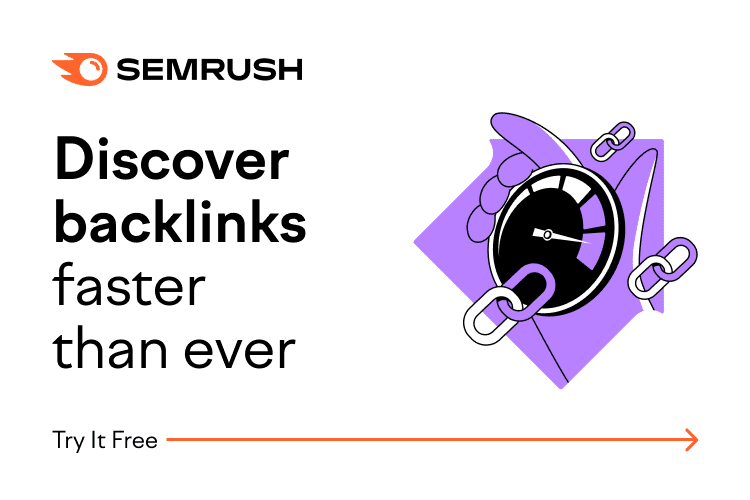Competitor Backlink Analysis and Link Building With Semrush
Are you unsure of how to leverage backlinks to improve the search engine rankings for your website? Competitor backlink analysis can help you immensely to understand what type of backlink strategy your rivals are using. A tool like Semrush Backlink Analytics can reveal where the backlinks are coming from and how trusted these sources are in the eyes of search engines like Google.
Studying competitor backlinks can help you understand what sort of content your competitors are using to attract these external backlinks and locate gaps in your backlink profile that you need to fill in. You’ll also be able to identify backlink opportunities that you can take advantage of by reaching out to referring domains. Let’s find out what sort of insights you will be able to gain using Semrush’s competitor backlink analysis tools.
What Are Backlinks and Why Are They Important?

A backlink is made when one website links to another. Backlinks are very important since they can bring visitors and, therefore, web traffic from other websites to yours. Backlinks allow those browsing the web to find your domain and its content more easily. Backlinks are also referred to as ‘dofollow links’ or ‘inbound links’.
Another website will link to yours for a variety of reasons. Providing additional context to a reader, supporting a claim made in their website copy, indicating that your website is a source of information, or recommending your website are some of these reasons. A backlink tells search engines that the content at the destination can be trusted and valuable. This can result in your domain, webpages, and content being placed higher in search engine rankings, making backlink analysis a key part of search engine optimization (SEO).
What Are Good Backlinks?

Not all backlinks are good for your website. Google will more readily trust inbound links to your website if the source, or ‘referring domain’, is a popular, well-known site with a good reputation. In addition to the high authority of the source, the anchor text for the backlink must be written properly, and the topic discussed there must be relevant to the content at the destination. If your backlinks meet all these conditions, then you have a good backlink, which can drive traffic to your domain.
Unfortunately, there are plenty of malicious sites on the internet that will try to fool Google’s systems. There could be unknown sites that backlink to your domain using poorly written anchor text. The content could even contain pop-ups, explicit content, or keyword stuffing. These types of backlinks are considered toxic, and they have a negative effect on your backlink profile, which can end in your domain being penalized by Google. If you want to remove toxic backlinks from your website, you can learn how to do it using the Semrush Backlink Audit Tool.

What Does Semrush Backlink Analytics Reveal About Your Competitors’ Backlink Strategy?
Since they play such an important role in your SEO strategy, it is in your interest to build backlinks that are of good quality and are made from trusted sites. At first, it might be difficult to figure out where to start with your link building strategy. This is where analyzing a competitor’s backlink profile can help you discover competitor backlinks that are helping them rank higher in the search engine results pages (SERPS).
By replicating competitor backlinks and identifying gaps in their backlink profile that you can target through outreach, you can compete much more effectively. By utilizing Semrush Backlink Analytics, you can find the best referring domains for link building to boost your domain’s web traffic. Let’s look at the tools Semrush has provided for competitor backlink analysis.
Overview of Your Competitor’s Backlinks

If you know who your main competitor is, you can start by opening up the Backlink Analytics tool contained within the Link Building section in your Semrush interface and entering their domain. Semrush will then analyze your competitor’s backlink data and present you with a dashboard view of their backlink profile.
You will be able to see your competitor’s authority score, which indicates their influence on SEO, and their toxicity score, which is a marker of toxic backlinks pointing at them. You will also notice information such as the number of referral domains, backlinks, monthly visitors, and more. Furthermore, there are plenty of timeline views that allow you to observe trends for this backlink data.
Deeper Analysis of Your Competitor’s Backlinks

If you enter the Backlinks tab, you can get an in-depth look at each of the backlinks pointing toward your competitor’s domain. You will be able to see the source, which is the referring domain, the target URL on your competitor’s website, the anchor text used, and even the type of backlink, whether it’s text-based or something else.
You can use multiple filters to sort all this backlink data. You can sort by link status (new, lost, active), backlink attributes, and whether the referring domain platform is a wiki, a blog, an online message board, etc. Backlink attributes can reveal whether the content is sponsored or user-generated.
Find Referring Domains of Your Competitor’s Backlinks

This tab breaks down your competitor’s backlink profile in terms of referring domains based on authority score. This is great because you can now see which backlinks are helping your competitors in their SEO and backlink strategy. If there are multiple backlinks originating from the same referral site, with many blog posts or news articles being written about your competitor, this could indicate some sort of partnership between them.
Find What Type of Content Is Receiving Backlinks

By switching to the Indexed Pages tab, you can view which landing pages on your competitor’s website are receiving backlinks. This will allow you to understand what type of content is attracting visitors to your competitor’s website. It could be a blog page, a list of frequently asked questions (FAQs), or a product guide. Maybe your competitor is experimenting with a new form of content that the referring domains are loving. You can now identify what it is and generate your own content to match.
Study Your Competitors’ Outreach Strategy

Link building isn’t easy, but you can get a sense of what your competitor is doing by using a backlink analysis tool like what Semrush has provided. If you have identified what your competitor’s best referring domains are, you can then try to find any existing patterns in this data. If there are backlinks being generated by a referring domain following a new product or service launch by your competitor, then it is possible that your competitor did some outreach to make it happen. If this is the case, there may be link-building opportunities for your company as well.
Find Backlink Opportunities From Backlink Gaps

Semrush has provided the Backlink Gaps tool so that you can compare competitor backlinks with your own across five different domains. You can find this tool in the Competitive Research section, where you can enter your domain and your competitors’ domains. You will then be presented with a list of the best referring domains that your competitors are using but not you. These are the gaps in your backlink profile that you need to fill in order to stay competitive.
You can also find some handy filters here to sort through these backlink gaps. The ‘strength’ filter will indicate backlinks that only you have. ‘Sharing’ will bring up backlinks that everyone is having. ‘Unique’ will show referring domains that are unique to one competitor, which might indicate an exclusive partnership between them. Finally, the ‘weak’ filter will show you where you need to step up your game.
Bulk Analysis of Backlinks

If you wish to compare competitor backlinks and profiles across more than five domains, then you need to use the Bulk Analysis tool provided by Semrush. You can expand your competitor backlink analysis scope up to 200 domains, obtaining information such as authority score, number of backlinks, number of referring domains, and much more. You can even export this backlink profile data to Excel or CSV.
Build Backlinks with Semrush

Analyzing your competitor’s backlinks is a key part of developing your own effective link building strategy and SEO strategy. Through Semrush Backlink Analytics, you can identify the origins of your competitor backlinks, what referring domains they’re from, and what sort of content attracted them in the first place. Competitor backlink analysis can also reveal trends, giving you an idea of how your competitors plan their marketing campaigns and outreach.
By analyzing multiple competitors in the same field, not only could you employ link building tactics that are proven to work, but you can even reach out to domains that might be interested in partnering with you. There may be lost or broken backlinks that your competitors are not paying attention to. These are backlink opportunities where you can swoop in and take those backlinks to your website instead.
If you feel ready to dip your toes into competitor backlink analysis, try out the Semrush Backlink Analysis Tools.

What is the best SEO tool for competitor backlink analysis?
There are a wide variety of SEO tools out there and which tool is best for you will depend on you, your workflow, and your preferences. That being said, I think Semrush is the best tool for competitor backlink analysis. In addition to analyzing competitor sites and presenting backlink gap analyses, Semrush provides you with an all-in-one SEO toolset to improve your website’s SEO.
What does Semrush competitor backlink analysis provide?
Semrush’s competitor backlink analysis tools are a must for any SEO strategy. You can use Semrush for competitive backlink analysis to:
➔ Get an overview of your competitors’ backlinks
➔ Get a deeper analysis of your competitors link profile
➔ Find the referring domains of your competitor’s backlinks
➔ Find what type of content is receiving the backlinks
➔ Study your competitors’ outreach strategy
➔ Find backlink gaps and opportunities
